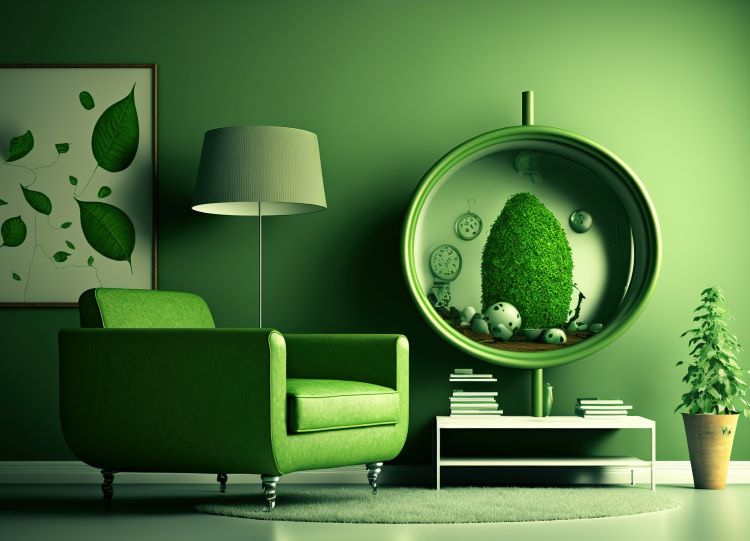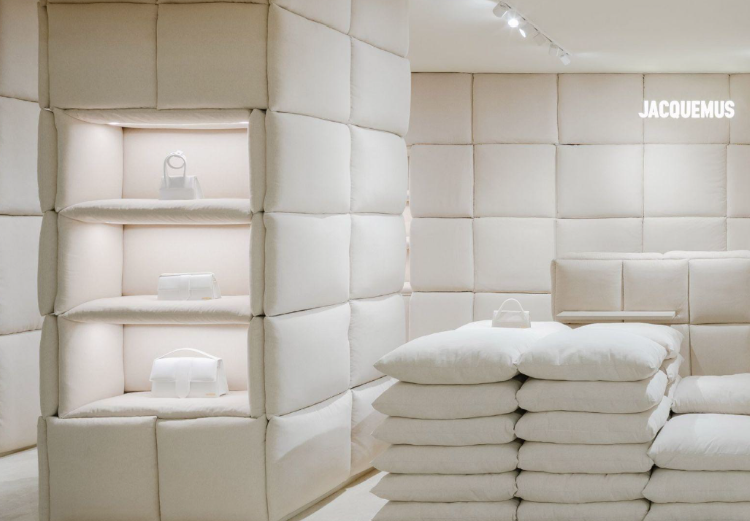Packing derived from algae. 3D printers on the manufacturing floor. Bio-based leathers on seating. Trackers that make supply chains transparent to consumers. These are some of the advancements in production and materials that will gain more widespread use in industries from fashion to furniture, according to a recent “The Future of Materials” report from FS, a global creative trend intelligence agency based in New York.

“Today, a growing ecosystem of farmers, scientists, engineers, designers and artisans are shifting their focus to prioritize materiality as the single most important component of all future design thinking,” said Nia Silva, director of materials for FS, in a seminar detailing the report’s findings. “… Future-facing innovations and future-facing solutions are continuing to reimagine how matter can be designed, how it can be used and how it can be refashioned in new.”
“The Future of Materials” is part of a series of “The Future of…” seminars intended to help brands, designers, marketers and others identify innovations, key movements and consumer shifts so that they can better understand their current markets and what’s ahead. FS gave attendees an overview of a half-dozen materials-related trends (fuller reports are available to its clients). We’re focusing more narrowly here on those most relevant to the home furnishings industry.
Ethical Foundations
What FS calls Ethical Foundations is perhaps the most important trend because it underlies other trends that will shape production in the future.
“Currently, as a society, we’re living in a time of accelerating levels of biodiversity loss, global production pressures and increasingly stressed ecosystems. So, in an effort to create a future for materials where nature is not only protected, but also sustained and thriving, it’s going to require thoughtful and repetitive solutions that take us back to the basics,” Silva said.
What this means:
- Companies adopting more mindful manufacturing and construction practices.
- Suppliers and manufacturers exploring new ways of cultivating and using materials. This includes adopting holistic, regenerative farming practices (crop rotation, composting, etc.) rather than industrial farming methods.
- Companies incorporating sustainability practices into broader business priorities.
“We see this influencing an uptick in brands who are discovering and really embracing the ways in which their products and their design choices can contribute to a wider ecosystem of ethical change for the betterment of us all,” Silva said.
Companies leading the way:
- Sustainable footwear brand Balena has designed the world’s first slide using tea waste and 100% biodegradable foam. The idea is that the shoe can be safely returned to the earth at the end of its useful life.
- Denim brand Citizens of Humanity partners with the Kiss the Ground nonprofit to support and fund U.S. cotton farmers.
Low Impact
“The International Energy Agency predicts that annual clean energy investment worldwide will need to more than triple by 2030 to around $4 trillion to reach net-zero emissions by 2050,” FS notes. “With governments continuing to pledge future commitments to carbon emission reduction, energy-intensive material sectors — namely those related to plastic, steel, cement, paper and textiles — will need to devise new and low-impact alternative measures to stay competitive.”
Silva added: “In the design world, the lowest environmental impact results from the prioritization of materials or components that are cyclical, that don’t require much processing energy or inputs — approaching design in transparent and traceable ways that minimize our effects as opposed to maximizing them.”
What this means:
- Producers and suppliers focusing on transparency and traceability throughout the supply chain.
- Companies striving to lower carbon emissions throughout the manufacturing process and across transportation routes.
- Circularity and sustainability — key low-impact strategies — are particularly important to the youngest generations of shoppers, millennials and Generation Z, who will drive furniture purchases in years to come.
“We’re seeing brands really push toward innovations centered on harnessing renewable and traceable solutions,” Silva said. “Suppliers and brands are becoming motivated to explore a new generation of materials through sequester carbon, and better trackers for transparent fiber supply chains, or even enhancing material efficiency through recyclable products and packaging initiatives.”
Companies leading the way:
- Cosmetics brand Forgo provides reusable glass dispensers and mix-it-yourself powdered soaps delivered in biodegradable paper mailers. Forgo is striving to reach net-zero carbon emissions by 2026.
- Haelixa offers ways to physically mark, trace and authenticate products from manufacturer to retailer to create transparent supply chains. Its technologies can be used on textiles, gold and other materials.
“Bactory”
This play on words focuses on the intersection of “biology” and the traditional “factory” to describe the growing world of bio-based design.
“From engineered pigments to ‘living’ garments, bio-design is the use of living organisms in design. Its processes can be used in the creation of fashion, of medicine, of furniture, of architecture. But we think the most exciting thing about the topic of bio-design … is that it’s rooted in questioning our forms of creation and consumption, and its applications are constantly multiplying,” Silva said.
It’s also big business. According to FS, bio-based startups raised nearly $8 billion in 2020, helping to push “the global bio-materials market to reach a projected value of $373 billion by 2028.” Bio-based products are currently most prevalent in the fashion sector. Scaling could allow more rapid expansion into other categories, as concepts move from the lab to the manufacturing floor.
What this means:
- Manufacturers will increasingly use bio-engineered alternatives to animal- and petroleum-based products such as leather, silk, polyester and fur. These alternatives include bacterial pigments, algae in a variety of forms, and lab-grown leathers.
- We’ll see increasing collaborations between product designers and scientists.
- New bio-based materials are a natural fit (pardon the pun) for more environmentally friendly packaging materials.
Companies leading the way:
- MycoWorks has announced a partnership with Ligne Roset to create a line of luxury home furnishings using Reishi mycelium — a key step in demonstrating that bio-leathers can move beyond apparel.
- Colorfix uses a textile dyeing process that unlocks nature’s pigments. It’s a shift away from “conventional methods requiring extensive water and chemical usage to microbial chemistry that grows color via fermentation instead,” FS says.
Consciously Renewed
Our consumerist culture has become increasingly wasteful, with most products meant to be tossed away rather than repaired, recycled or reused.
“And we’re constantly producing more and more and more. … But we think reframing the conversation in a positive and optimistic light is key here. We’re living in a reality where we have a lot of materials that already exist, but they’re not being used adequately — be it electronic waste, plastic waste, post-consumer textile waste, food waste, honestly, any waste,” Silva said. “So, these materials — these waste materials — will need to become the new raw materials of the future.” Thus, the idea of components and end products being Consciously Renewed.
Younger consumers are more receptive to sustainable and circular products, realizing that they are the next generation that will have to deal with growing piles of waste on land and sea.
What this means:
- Rising commodity prices make reuse of materials and components more attractive to producers.
- Companies can transform their manufacturing processes by upcycling offcuts and deadstocks.
- Some producers may want to consider creating value-added repairability, refinishing or reupholstery programs.
“Repurposing waste will become a more common and more economically sound avenue of creative stewardship for suppliers, designers and brands who want to create more meaningfully and resourcefully,” Silva said.
Companies leading the way:
- German designer Frederik Rasenberger turns cardboard and plastic bottles into 3D printed Cozy Cleo lamps.
- Renewcell offers Circulose, an alternative fiber generated from cotton-rich clothing waste. The fabric created from Circulose is 100% biodegradable and entirely circular.
Streamlined Process
“As brands and suppliers navigate the next frontier of manufacturing, streamlining becomes a top priority — providing an innovative pathway toward improved quality, speed and efficiency to increase revenue,” according to FS. “For example, (in fashion) instead of a typical multistage manufacturing process involving yarn spinning, weaving, knitting, cutting and sewing, we’re now seeing fully fashioned garments being transformed into finished goods within one mechanized process.”
What this means:
- Manufacturers will increasingly edit and improve their current practices using all-in-one technologies and machinery that eliminate steps, speed production and reduce waste.
- 3D printing will continue to revolutionize construction and other manufacturing.
“Moving forward, suppliers will have no choice but to question their current practices and consider all-in-one technologies that could soon outpace their predecessors,” FS says.
Companies leading the way:
- Startups Mighty Buildings and Icon are exploring 3D printing in building construction, with the potential to reduce waste by 99% and labor hours by 95%, according to FS.
- Textile company Weffan is using its 3D woven technology to increase efficiency and design out waste.


